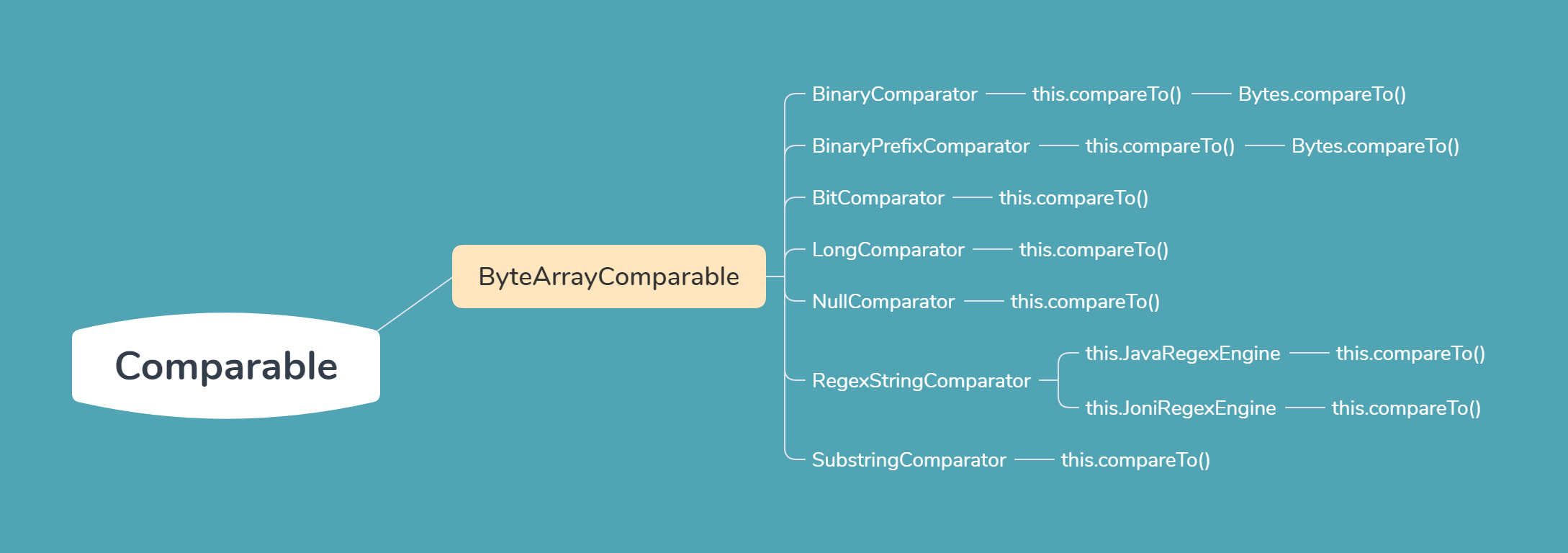**前言:本篇文章主要对HBase过滤器之比较器作一个补充介绍,也算是HBase Filter学习的必备低阶魂技吧。本篇文中源码基于HBase 1.1.2.2.6.5.0-292 HDP版本。
HBase所有的比较器实现类都继承于父类ByteArrayComparable,而ByteArrayComparable又实现了Comparable接口;不同功能的比较器差别在于对父类compareTo()方法的重写逻辑不同。
下面分别对HBase Filter默认实现的七大比较器一一进行介绍。
1. BinaryComparator
**介绍:**二进制比较器,用于按字典顺序比较指定字节数组。
先看一个小例子:
public class BinaryComparatorDemo {
public static void main(String[] args) {
BinaryComparator bc = new BinaryComparator(Bytes.toBytes("bbb"));
int code1 = bc.compareTo(Bytes.toBytes("bbb"), 0, 3);
System.out.println(code1); // 0
int code2 = bc.compareTo(Bytes.toBytes("aaa"), 0, 3);
System.out.println(code2); // 1
int code3 = bc.compareTo(Bytes.toBytes("ccc"), 0, 3);
System.out.println(code3); // -1
int code4 = bc.compareTo(Bytes.toBytes("bbf"), 0, 3);
System.out.println(code4); // -4
int code5 = bc.compareTo(Bytes.toBytes("bbbedf"), 0, 6);
System.out.println(code5); // -3
}
}
不难看出,该比较器的比较规则如下:
- 两个字符串首字母不同,则该方法返回首字母的asc码的差值
- 参与比较的两个字符串如果首字符相同,则比较下一个字符,直到有不同的为止,返回该不同的字符的asc码差值
- 两个字符串不一样长,可以参与比较的字符又完全一样,则返回两个字符串的长度差值
看一下以上规则对应其compareTo()方法的源码实现:
实现一:
static enum UnsafeComparer implements Bytes.Comparer<byte[]> {
INSTANCE;
....
public int compareTo(byte[] buffer1, int offset1, int length1, byte[] buffer2, int offset2, int length2) {
if (buffer1 == buffer2 && offset1 == offset2 && length1 == length2) {
return 0;
} else {
int minLength = Math.min(length1, length2);
int minWords = minLength / 8;
long offset1Adj = (long)(offset1 + BYTE_ARRAY_BASE_OFFSET);
long offset2Adj = (long)(offset2 + BYTE_ARRAY_BASE_OFFSET);
int j = minWords << 3;
int offset;
for(offset = 0; offset < j; offset += 8) {
long lw = theUnsafe.getLong(buffer1, offset1Adj + (long)offset);
long rw = theUnsafe.getLong(buffer2, offset2Adj + (long)offset);
long diff = lw ^ rw;
if (diff != 0L) {
return lessThanUnsignedLong(lw, rw) ? -1 : 1;
}
}
offset = j;
int b;
int a;
if (minLength - j >= 4) {
a = theUnsafe.getInt(buffer1, offset1Adj + (long)j);
b = theUnsafe.getInt(buffer2, offset2Adj + (long)j);
if (a != b) {
return lessThanUnsignedInt(a, b) ? -1 : 1;
}
offset = j + 4;
}
if (minLength - offset >= 2) {
short sl = theUnsafe.getShort(buffer1, offset1Adj + (long)offset);
short sr = theUnsafe.getShort(buffer2, offset2Adj + (long)offset);
if (sl != sr) {
return lessThanUnsignedShort(sl, sr) ? -1 : 1;
}
offset += 2;
}
if (minLength - offset == 1) {
a = buffer1[offset1 + offset] & 255;
b = buffer2[offset2 + offset] & 255;
if (a != b) {
return a - b;
}
}
return length1 - length2;
}
}
实现二:
static enum PureJavaComparer implements Bytes.Comparer<byte[]> {
INSTANCE;
private PureJavaComparer() {
}
public int compareTo(byte[] buffer1, int offset1, int length1, byte[] buffer2, int offset2, int length2) {
if (buffer1 == buffer2 && offset1 == offset2 && length1 == length2) {
return 0;
} else {
int end1 = offset1 + length1;
int end2 = offset2 + length2;
int i = offset1;
for(int j = offset2; i < end1 && j < end2; ++j) {
int a = buffer1[i] & 255;
int b = buffer2[j] & 255;
if (a != b) {
return a - b;
}
++i;
}
return length1 - length2;
}
}
}
实现一是对实现二的一个优化,都引自Bytes类,HBase优先执行实现一方案,如果有异常再执行实现二方案。如下:
public static int compareTo(byte[] buffer1, int offset1, int length1, byte[] buffer2, int offset2, int length2) {
return Bytes.LexicographicalComparerHolder.BEST_COMPARER.compareTo(buffer1, offset1, length1, buffer2, offset2, length2);
}
...
...
static final String UNSAFE_COMPARER_NAME = Bytes.LexicographicalComparerHolder.class.getName() + "$UnsafeComparer";
static final Bytes.Comparer<byte[]> BEST_COMPARER = getBestComparer();
static Bytes.Comparer<byte[]> getBestComparer() {
try {
Class<?> theClass = Class.forName(UNSAFE_COMPARER_NAME);
Bytes.Comparer<byte[]> comparer = (Bytes.Comparer)theClass.getEnumConstants()[0];
return comparer;
} catch (Throwable var2) {
return Bytes.lexicographicalComparerJavaImpl();
}
}
2. BinaryPrefixComparator
**介绍:**二进制比较器,只比较前缀是否与指定字节数组相同。
先看一个小例子:
public class BinaryPrefixComparatorDemo {
public static void main(String[] args) {
BinaryPrefixComparator bc = new BinaryPrefixComparator(Bytes.toBytes("b"));
int code1 = bc.compareTo(Bytes.toBytes("bbb"), 0, 3);
System.out.println(code1); // 0
int code2 = bc.compareTo(Bytes.toBytes("aaa"), 0, 3);
System.out.println(code2); // 1
int code3 = bc.compareTo(Bytes.toBytes("ccc"), 0, 3);
System.out.println(code3); // -1
int code4 = bc.compareTo(Bytes.toBytes("bbf"), 0, 3);
System.out.println(code4); // 0
int code5 = bc.compareTo(Bytes.toBytes("bbbedf"), 0, 6);
System.out.println(code5); // 0
int code6 = bc.compareTo(Bytes.toBytes("ebbedf"), 0, 6);
System.out.println(code6); // -3
}
}
该比较器只是基于BinaryComparator比较器稍作更改而已,以下代码一目了然:
public int compareTo(byte[] value, int offset, int length) {
return Bytes.compareTo(this.value, 0, this.value.length, value, offset, this.value.length <= length ? this.value.length : length);
}
看一下同BinaryComparator方法的异同:
public int compareTo(byte[] value, int offset, int length) {
return Bytes.compareTo(this.value, 0, this.value.length, value, offset, length);
}
区别只在于最后一个传参,即length=min(this.value.length,value.length),取小。这样在后面的字节逐位比较时,即只需比较min length次。
3. BitComparator
**介绍:**位比价器,通过BitwiseOp提供的AND(与)、OR(或)、NOT(非)进行比较。返回结果要么为1要么为0,仅支持 EQUAL 和非 EQUAL。
先看一个小例子:
public class BitComparatorDemo {
public static void main(String[] args) {
// 长度相同按位或比较:由低位起逐位比较,每一位按位或比较都为0,则返回1,否则返回0。
BitComparator bc1 = new BitComparator(new byte[]{0,0,0,0}, BitComparator.BitwiseOp.OR);
int i = bc1.compareTo(new byte[]{0,0,0,0}, 0, 4);
System.out.println(i); // 1
// 长度相同按位与比较:由低位起逐位比较,每一位按位与比较都为0,则返回1,否则返回0。
BitComparator bc2 = new BitComparator(new byte[]{1,0,1,0}, BitComparator.BitwiseOp.AND);
int j = bc2.compareTo(new byte[]{0,1,0,1}, 0, 4);
System.out.println(j); // 1
// 长度相同按位异或比较:由低位起逐位比较,每一位按位异或比较都为0,则返回1,否则返回0。
BitComparator bc3 = new BitComparator(new byte[]{1,0,1,0}, BitComparator.BitwiseOp.XOR);
int x = bc3.compareTo(new byte[]{1,0,1,0}, 0, 4);
System.out.println(x); // 1
// 长度不同,返回1,否则按位比较
BitComparator bc4 = new BitComparator(new byte[]{1,0,1,0}, BitComparator.BitwiseOp.XOR);
int y = bc4.compareTo(new byte[]{1,0,1}, 0, 3);
System.out.println(y); // 1
}
}
上述注释阐述的规则,对应以下代码:
···
public int compareTo(byte[] value, int offset, int length) {
if (length != this.value.length) {
return 1;
} else {
int b = 0;
for(int i = length - 1; i >= 0 && b == 0; --i) {
switch(this.bitOperator) {
case AND:
b = this.value[i] & value[i + offset] & 255;
break;
case OR:
b = (this.value[i] | value[i + offset]) & 255;
break;
case XOR:
b = (this.value[i] ^ value[i + offset]) & 255;
}
}
return b == 0 ? 1 : 0;
}
}
···
核心思想就是:由低位起逐位比较,直到b!=0退出循环。
4. LongComparator
**介绍:**Long 型专用比较器,返回值:0 -1 1。上篇概述没有提到,这里补上。
先看一个小例子:
public class LongComparatorDemo {
public static void main(String[] args) {
LongComparator longComparator = new LongComparator(1000L);
int i = longComparator.compareTo(Bytes.toBytes(1000L), 0, 8);
System.out.println(i); // 0
int i2 = longComparator.compareTo(Bytes.toBytes(1001L), 0, 8);
System.out.println(i2); // -1
int i3 = longComparator.compareTo(Bytes.toBytes(998L), 0, 8);
System.out.println(i3); // 1
}
}
这个比较器实现相当简单,不多说了,如下:
public int compareTo(byte[] value, int offset, int length) {
Long that = Bytes.toLong(value, offset, length);
return this.longValue.compareTo(that);
}
5. NullComparatorDemo
**介绍:**控制比较式,判断当前值是不是为null。是null返回0,不是null返回1,仅支持 EQUAL 和非 EQUAL。
先看一个小例子:
public class NullComparatorDemo {
public static void main(String[] args) {
NullComparator nc = new NullComparator();
int i1 = nc.compareTo(Bytes.toBytes("abc"));
int i2 = nc.compareTo(Bytes.toBytes(""));
int i3 = nc.compareTo(null);
System.out.println(i1); // 1
System.out.println(i2); // 1
System.out.println(i3); // 0
}
}
这个比较器实现相当简单,不多说了,如下:
public int compareTo(byte[] value) {
return value != null ? 1 : 0;
}
6. RegexStringComparator
**介绍:**提供一个正则的比较器,支持正则表达式的值比较,仅支持 EQUAL 和非 EQUAL。匹配成功返回0,匹配失败返回1。
先看一个小例子:
public class RegexStringComparatorDemo {
public static void main(String[] args) {
RegexStringComparator rsc = new RegexStringComparator("abc");
int abc = rsc.compareTo(Bytes.toBytes("abcd"), 0, 3);
System.out.println(abc); // 0
int bcd = rsc.compareTo(Bytes.toBytes("bcd"), 0, 3);
System.out.println(bcd); // 1
String check = "^([a-z0-9A-Z]+[-|\\.]?)+[a-z0-9A-Z]@([a-z0-9A-Z]+(-[a-z0-9A-Z]+)?\\.)+[a-zA-Z]{2,}$";
RegexStringComparator rsc2 = new RegexStringComparator(check);
int code = rsc2.compareTo(Bytes.toBytes("zpb@163.com"), 0, "zpb@163.com".length());
System.out.println(code); // 0
int code2 = rsc2.compareTo(Bytes.toBytes("zpb#163.com"), 0, "zpb#163.com".length());
System.out.println(code2); // 1
}
}
其compareTo()方法有两种引擎实现,对应两套正则匹配规则,分别是JAVA版和JONI版(面向JRuby),默认为RegexStringComparator.EngineType.JAVA。如下:
public int compareTo(byte[] value, int offset, int length) {
return this.engine.compareTo(value, offset, length);
}
public static enum EngineType {
JAVA,
JONI;
private EngineType() {
}
}
具体实现都很简单,都是调用正则语法匹配。以下是JAVA EngineType 实现:
public int compareTo(byte[] value, int offset, int length) {
String tmp;
if (length < value.length / 2) {
tmp = new String(Arrays.copyOfRange(value, offset, offset + length), this.charset);
} else {
tmp = new String(value, offset, length, this.charset);
}
return this.pattern.matcher(tmp).find() ? 0 : 1;
}
JONI EngineType 实现:
public int compareTo(byte[] value, int offset, int length) {
Matcher m = this.pattern.matcher(value);
return m.search(offset, length, this.pattern.getOptions()) < 0 ? 1 : 0;
}
都很容易理解,不多说了。
7. SubstringComparator
**介绍:**判断提供的子串是否出现在value中,并且不区分大小写。包含字串返回0,不包含返回1,仅支持 EQUAL 和非 EQUAL。
先看一个小例子:
public class SubstringComparatorDemo {
public static void main(String[] args) {
String value = "aslfjllkabcxxljsl";
SubstringComparator sc = new SubstringComparator("abc");
int i = sc.compareTo(Bytes.toBytes(value), 0, value.length());
System.out.println(i); // 0
SubstringComparator sc2 = new SubstringComparator("abd");
int i2 = sc2.compareTo(Bytes.toBytes(value), 0, value.length());
System.out.println(i2); // 1
SubstringComparator sc3 = new SubstringComparator("ABC");
int i3 = sc3.compareTo(Bytes.toBytes(value), 0, value.length());
System.out.println(i3); // 0
}
}
这个比较器实现也相当简单,不多说了,如下:
public int compareTo(byte[] value, int offset, int length) {
return Bytes.toString(value, offset, length).toLowerCase().contains(this.substr) ? 0 : 1;
}
到此,七种比较器就介绍完了。如果对源码不敢兴趣,也建议一定要看看文中的小例子,熟悉下每种比较器的构造函数及结果输出。后续在使用HBase过滤器的过程中,会经常用到。当然除了这七种比较器,大家也可以自定义比较器。
共同学习,写下你的评论
评论加载中...
作者其他优质文章






